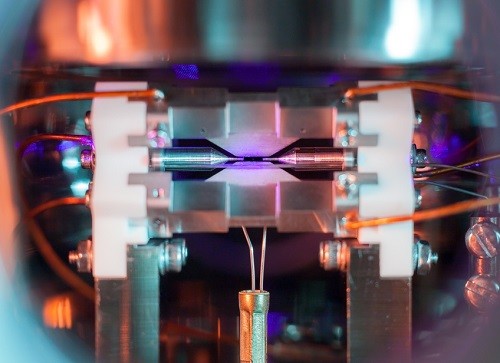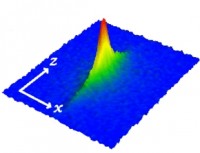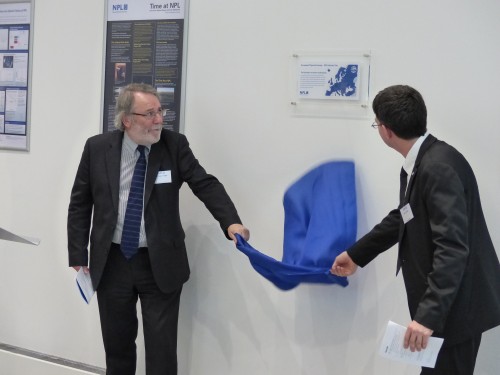Tag archives: ultracold atoms
Photography prize, Tesla collision course, climate-change cross stitch

Pale blue dot: image of a strontium atom in an ion trap bags national photography prize (courtesy: David Nadlinger – University of Oxford)
By Michael Banks
An image of a single positively-charged strontium atom that is held in an ion trap by electric fields has won a national science photography competition organised by the UK’s Engineering and Physical Sciences Research Council.
Taken by PhD student David Nadlinger from the University of Oxford, the image shows the light emitted from the atom when it absorbs laser light tuned to a specific frequency. The picture was taken through a window of the ultra-high vacuum chamber that houses the ion trap.
“The idea of being able to see a single atom with the naked eye had struck me as a wonderfully direct and visceral bridge between the minuscule quantum world and our macroscopic reality,” says Nadlinger. “When I set off to the lab with camera and tripods one quiet Sunday afternoon, I was rewarded with this particular picture of a small, pale blue dot.”
Moving onto space, the successful launch of SpaceX‘s Falcon Heavy rocket last week resulted in a Tesla Roadster (formally owned by SpaceX boss Elon Musk) in orbit around the Sun. Used only as a test mass, the car featured a spacesuit-clad mannequin called “Starman” in the driver’s seat.
The landscapes of CERN, 20 years of BECs and the truth about toilet swirl
By Hamish Johnston
Everyone knows that water in a draining sink or toilet swirls in opposite directions on opposite sides of the equator…or does it? For the answer, watch the instructions in the above video and then go to “The truth about toilet swirl”.
Physicists at CERN are a lucky bunch. As well as having the world’s most energetic collider at their disposal, they are also surrounded by the natural beauty of the Alps and the Jura mountains. However, I’ve always felt that the CERN site itself and the flat farmland that overlays the Large Hadron Collider (LHC) are rather dull.
View all posts by this author | View this author's profile
Where is the coldest experiment on Earth?

Chilly peak: a refocused cloud of rubidium atoms. (Courtesy: Tim Kovachy et al./Physical Review Letters)
By Hamish Johnston
California might be suffering a punishing drought, but a tiny corner of the Golden State is now the coldest place on Earth. This tiny super-cold patch was created at Stanford University by Mark Kasevich and colleagues, who have used “matter-wave lensing” to cool a cloud of about 100,000 rubidium atoms to less than 50 pK. That is just 50 × 10–12 degrees kelvin above absolute zero.
The temperature of a cloud of atoms is defined by the average velocity of the atoms as they drift about. Kasevich’s team used a series of lenses to reduce this average motion to less than 70 µm/s, which corresponds to 50 pK. This shatters the previous record of 1 nK for matter-wave lensing and represents “record-low kinetic temperatures” according to Physical Review Letters, where the research is described.
View all posts by this author | View this author's profile
Celebrating Louis Essen and the birth of atomic time

Peter Knight (left) and John Dudley unveiling the historic plaque.
By Hamish Johnston
On Friday I braved the torrential rains that have been soaking southern England to make the journey from Bristol to Teddington, which is the birthplace of the atomic clock. Situated in the leafy suburbs west of London on the swollen banks of the River Thames, Teddington is the home of the National Physical Laboratory (NPL), which is the UK’s standards and metrology lab.